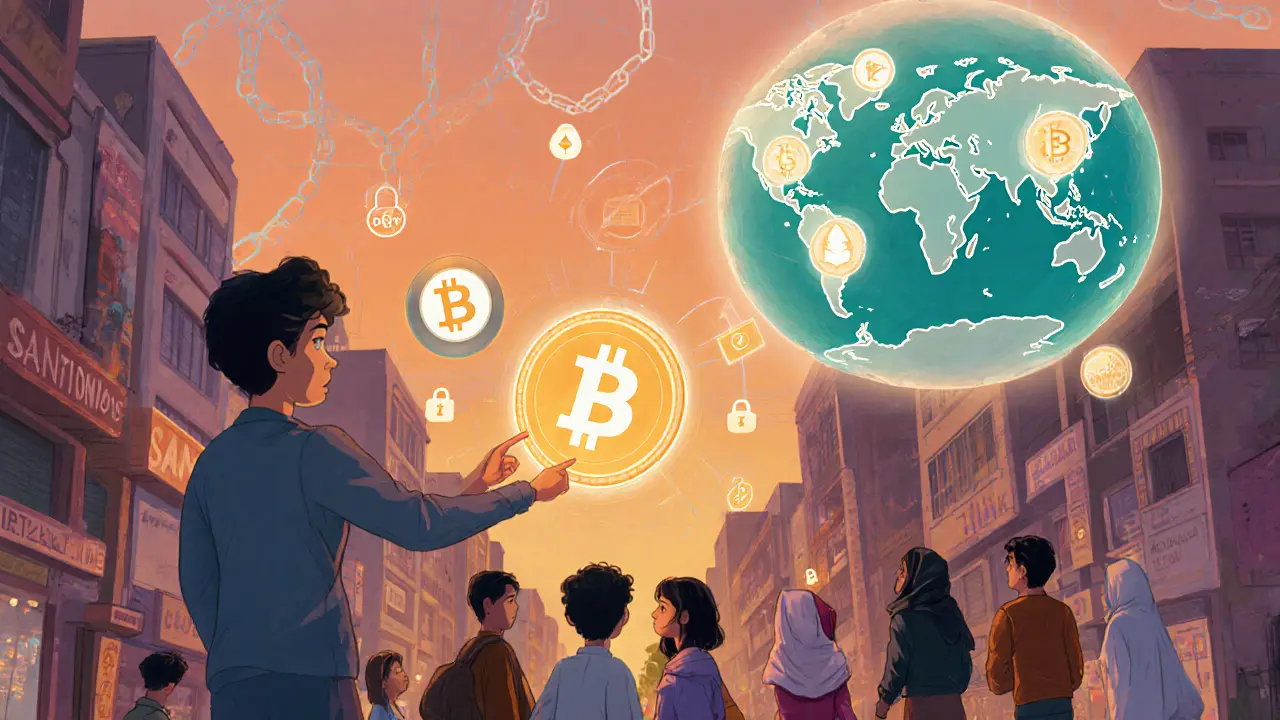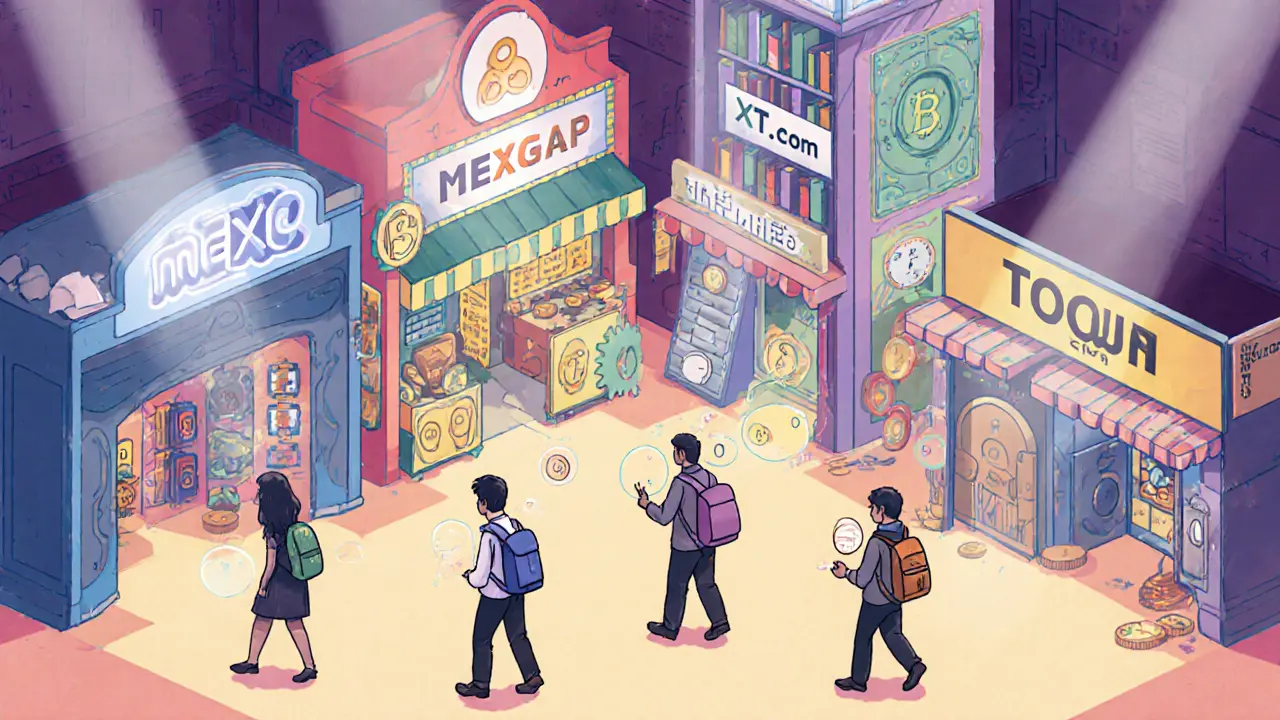Posted By Tristan Valehart On 9 Nov 2024 Comments (15)

Crypto Exchange Selector for Iranian Users
Iranian crypto enthusiasts face a unique set of hurdles: international sanctions, limited banking options, and a fast‑changing regulatory landscape. Yet the demand for digital assets remains huge, with over 11million users seeking ways to trade, invest, or simply move money across borders. This guide lists the crypto exchanges that still welcome Iranian citizens in 2025, compares their key features, and shows how to stay safe while navigating sanctions‑related risks.
Quick takeaways
- Domestic leader Nobitex handles 87% of Iran’s crypto volume, but it is under sanctions and suffered a $90million hack in June 2025.
- International platforms still open to Iranian residents include MEXC, Bitsgap, XT.com, LATOKEN and CoinEx.
- Fees range from 0.2% to 0.49% per spot trade; minimum deposits vary from $0 to $30.
- Compliance checks (KYC) are mandatory on most platforms, but some offer lighter verification for low‑volume accounts.
- Security best practices - use hardware wallets, enable 2FA, and avoid storing large sums on any single exchange.
The Iranian crypto ecosystem in 2025
Sanctions have cut off most traditional banking routes, making crypto a vital lifeline for individuals and businesses. According to recent intelligence, more than 11million Iranians use digital assets daily, either to protect wealth or to bypass cross‑border restrictions.
Domestically, Nobitex is Iran’s biggest crypto exchange, covering roughly 87% of local trading activity. It offers a familiar Persian interface and supports popular coins like Bitcoin, Ethereum, and USDT. However, the platform is now listed as a sanctioned entity by several jurisdictions, and a massive hack on 18June 2025 siphoned over $90million in assets. The incident exposed how deeply intertwined Nobitex is with networks that some analysts link to the IRGC.
Because of these pressures, many Iranian users turn to overseas platforms that promise broader coin selections, stronger security, and a chance to avoid direct sanctions exposure. Yet international exchanges must still comply with U.S. and EU AML rules, so the tolerance level varies from one service to another.
Why you might need an international exchange
- Broader market access: More than 1,000 crypto pairs are listed on top global platforms versus a few dozen on domestic sites.
- Advanced features: Futures, margin, copy‑trading, and staking are often absent from local exchanges.
- Liquidity: Higher trading volumes mean tighter spreads and faster order execution.
- Security: Established exchanges invest heavily in custodial security, insurance, and cold‑storage solutions.
- Regulatory resilience: Even if a platform tightens its policy later, users can usually withdraw funds to a personal wallet.
Top international exchanges that accept Iranian residents (September2025 data)
| Exchange | Overall Score | Min. Deposit | # of Coins | Spot Maker Fee | KYC Level |
|---|---|---|---|---|---|
| MEXC | 9.1 | $30 | 196 | 0.2% | Standard (ID + selfie) |
| Bitsgap | 8.4 | $0 | 673 | Varies by linked exchange | Optional (depends on connected exchange) |
| XT.com | 8.3 | $10 | 1,010 | 0.2% | Standard (ID + address verification) |
| LATOKEN | 8.0 | $1 | 475 | 0.49% | Standard (ID + proof of residence) |
| CoinEx | 7.9 | $1 | 475 | 0.49% | Standard (ID + selfie) |

Spotlight on each platform
MEXC - High‑score, low‑fee option
MEXC tops the rating charts with a 9.1 score. It supports 196 crypto assets and offers a flat 0.2% maker fee for spot trades. Iranian users must provide a government‑issued ID and a selfie for KYC, but the process is fully automated. The platform also hosts futures contracts, lending, and staking, making it a one‑stop shop for active traders.
Bitsgap - Automation‑focused gateway
Bitsgap isn’t an exchange per se; it connects to dozens of other markets and lets you run trading bots, arbitrage strategies, and copy‑trading. Because the actual trades happen on partner exchanges, Bitsgap can sometimes bypass stricter KYC on the front end. Iranian residents can start without a minimum deposit, but they’ll need to link a supported exchange that accepts their account.
XT.com - Massive coin list, modest fees
With over 1,000 supported tokens, XT.com offers the widest selection for Iranian traders. The $10 minimum deposit is low enough for most users, and the 0.2% maker fee matches MEXC’s best rate. KYC includes ID, selfie, and a short address verification step, which helps the platform stay compliant with global AML rules.
LATOKEN - Low entry barrier
LATOKEN’s $1 minimum deposit and 0.49% maker fee make it attractive for beginners. The exchange also runs token launch events, which can be a way for Iranians to get in early on new projects. KYC is standard, requiring ID and proof of residence - a step that can be tricky for users with limited documentation.
CoinEx - Balanced feature set
CoinEx offers spot, futures, and a staking marketplace. Its $1 entry point and 0.49% fee sit between the low‑cost MEXC/XT.com options and the higher‑fee platforms. The KYC flow mirrors LATOKEN’s, and the exchange has a solid reputation for quick withdrawals.
KuCoin - Highly rated by the community
According to CexFinder, KuCoin scores 4.4/5, making it a favorite among Iranian users who value a user‑friendly interface and a wide range of low‑cap altcoins. KuCoin also offers crypto loans, staking, and a “Earn” program that yields up to 12% APY on certain assets. KYC is optional for low‑volume accounts, which can be convenient but may limit fiat on‑ramps.
Choosing the right exchange - decision criteria
- Fees & deposit limits: If you trade small amounts daily, a platform with zero minimum (Bitsgap) or a low deposit ($1 LATOKEN) saves money.
- KYC strictness: Some users prefer exchanges that allow limited activity without full verification (KuCoin). Others accept full KYC for higher limits.
- Coin coverage: For niche tokens, XT.com’s 1,010‑coin catalog is unbeatable.
- Security track record: Look for platforms that have never suffered a major breach; MEXC and KuCoin have solid histories.
- Supported fiat methods: Direct IRR deposits are rare; most Iranians use USDT, DAI, or stablecoins on Polygon to move funds.
Security and sanctions: Risks you can’t ignore
Iranian users sit at the intersection of crypto’s borderless nature and geopolitical enforcement. In July2025, Tether froze 42 wallets linked to Iranian activity, wiping out millions of USDT holdings. The freeze forced many traders to swap USDT for DAI on the Polygon network - a cheaper, faster alternative that kept liquidity alive.
Key risks include:
- Account freezing: Even reputable platforms can block accounts if they receive a sanctions notice.
- Hacks: The $90million Nobitex breach showed how a single point of failure can devastate a whole ecosystem.
- Regulatory changes: Iran’s new capital‑gains tax law (August2025) means profits are now taxable, adding another compliance layer.
Mitigation steps:
- Keep most assets in a hardware wallet (e.g., Ledger, Trezor).
- Enable two‑factor authentication (SMS or authenticator app) on every exchange.
- Diversify across at least two exchanges to avoid total lockout.
- Regularly withdraw profits to a personal wallet and track them for tax reporting.
How to start trading on an international exchange (step‑by‑step)
- Choose a platform from the table above based on fee, coin list, and KYC comfort.
- Visit the exchange’s sign‑up page and register with a valid email.
- Complete the KYC process - upload a passport or national ID, a selfie, and proof of residence if required.
- Secure your account: set a strong password, enable 2FA, and consider adding an anti‑phishing code.
- Deposit a stablecoin (USDT, DAI, or USDC). If USDT is restricted, use DAI on Polygon as many Iranians did after the July freeze.
- Place a small test trade to verify that withdrawals work smoothly.
- Scale up your positions, but always keep a portion of your portfolio in a personal cold wallet.
Future outlook for Iranian crypto users
Despite sanctions, the Iranian crypto market is unlikely to disappear. The government’s move to tax crypto profits signals a shift toward formal regulation rather than outright bans. Meanwhile, users continue to innovate - swapping stablecoins on faster networks, using decentralized finance protocols, and even exploring layer‑2 solutions for lower fees.
Expect three trends to dominate the next 12‑18 months:
- Increased use of Polygon‑based DAI: Faster transactions and lower costs make it the default stablecoin after the Tether freeze.
- Growth of decentralized exchanges (DEXs): Platforms like Uniswap and SushiSwap on Polygon allow Iranians to trade without a centralized KYC gate.
- More stringent KYC on global exchanges: As enforcement intensifies, exchanges may require additional documentation, pushing users toward privacy‑focused wallets.
Staying informed, diversifying risk, and keeping a portion of assets off‑exchange will help you navigate whatever comes next.

Frequently Asked Questions
Can I open a Binance account as an Iranian citizen?
Binance has tightened its policy in 2025 and now blocks accounts that list Iran as a residence. Some users still manage to register using VPNs, but they risk sudden freezes and loss of funds. For a more reliable experience, consider the platforms listed in the comparison table.
Is it safe to trade USDT after the July 2025 freeze?
USDT remains usable on many exchanges, but the risk of additional freezes is higher. Switching to DAI on Polygon or other stablecoins that aren’t directly tied to Tether reduces exposure to future freezes.
Do I need to pay Iran’s new crypto capital‑gains tax?
Yes. The August2025 law requires reporting of crypto profits similar to stock or real‑estate gains. Keep records of trade dates, amounts, and fees to calculate your tax liability accurately.
What’s the cheapest way to withdraw crypto to a personal wallet?
Polygon network withdrawals typically cost under $0.01, making DAI transfers the most cost‑effective option. Avoid Ethereum mainnet withdrawals unless you need the higher security it offers.
Can I use a hardware wallet with any of the listed exchanges?
Most of the exchanges support withdrawal to hardware wallets like Ledger and Trezor. You’ll need to add your wallet address to the exchange’s withdrawal whitelist and complete any additional security prompts.


Henry Mitchell IV
November 9, 2024 AT 12:30Nice list, but watch out for hidden fees 😊
WILMAR MURIEL
November 13, 2024 AT 15:13For anyone just diving into the scene, the first thing to nail down is a solid security posture – get a hardware wallet like Ledger or Trezor and keep the bulk of your crypto there.
Next, make sure every exchange you use has two‑factor authentication enabled and, if possible, use an authenticator app rather than SMS.
When you’re choosing between the platforms listed, think about what you actually need: if you’re a casual trader, LATOKEN or CoinEx with their $1 minimum might be the most painless way to get started.
If you’re after more advanced features like futures or copy‑trading, MEXC and XT.com give you that toolbox without charging you an arm and a leg on fees.
Don’t forget to diversify – keep accounts on at least two exchanges so you aren’t left high‑and‑dry if a sanction notice hits one of them.
Also, be aware that many of these services still require KYC for higher limits; if you’re okay with a lower ceiling, you can often stay under the radar with minimal verification, but that comes with trade‑size restrictions.
Take note of the fee structures: a flat 0.2% maker fee on MEXC or XT.com is a solid baseline, while the 0.49% on LATOKEN and CoinEx can add up if you’re a high‑frequency trader.
Remember that the minimum deposit can also act as a barrier – if you only have a few dollars to start, Bitsgap’s $0 minimum or LATOKEN’s $1 entry point are attractive options.
One tip that many overlook is to keep a small amount of stablecoin on the exchange for quick trades, but withdraw any profits to your personal wallet as soon as possible to avoid freeze risks.
In the event of a freeze, having your assets in a hardware wallet means you can still access your funds and move them elsewhere without waiting on the exchange’s bureaucracy.
Tax compliance is another piece of the puzzle – Iran’s new capital‑gains tax means you should log every trade, noting dates, amounts, and fees, so you’re ready for filing season.
For record‑keeping, a simple spreadsheet or a tool like CoinTracker can automate the heavy lifting.
Lastly, keep an eye on network fees – using Polygon for DAI transfers usually costs less than a cent, making it the cheapest way to move money out of an exchange.
All in all, the landscape is messy, but with careful planning you can stay on the right side of both security and regulation.
Stay safe, stay informed, and don’t let the sanctions scare you away from using crypto as a tool for financial freedom.
jit salcedo
November 17, 2024 AT 16:26When you look at the grand chessboard of geopolitics, every exchange that still dares to open its doors to Iranian citizens becomes a quiet rebel, a digital oasis in a desert of sanctions.
Their very existence whispers of a hidden network, a web of whispers and encrypted tunnels that the powers that be would love to see snuffed out.
Think about it: every transaction is a breadcrumb, a trail that could be followed by the watchful eyes of the Great Powers, waiting for a misstep to crush the fragile freedom of the Iranian crypto community.
These platforms are not just services; they are lifelines, encrypted lifelines, flickering in the storm of financial isolation.
And yet, as soon as a large enough chunk of capital flows through them, the regulators slap a fresh set of KYC demands, or the exchange freezes accounts with the speed of a lightning strike.
It’s a cat‑and‑mouse game, where the mice are ordinary people trying to protect their savings, and the cat is an ever‑evolving sanctions regime.
Do not be fooled by glossy interfaces – behind the UI lies a battlefield of code and policy, and you, my friend, are a soldier armed with a private key.
Every time you move a token, you are subtly challenging the edicts imposed from far‑away capitals.
Remember the Tether freeze of July 2025 – that was a reminder that even the biggest stablecoin can be weaponized against a nation.
So diversify, hide in the shadows of decentralized exchanges, and keep a hardware wallet as your personal vault.
The secret is to stay anonymous enough to avoid the radar, yet transparent enough to prove ownership when you need to cash out.
And never, ever trust a single point of failure; spread your holdings across multiple platforms like a prudent smuggler hides his loot in several crates.
The future may bring harsher crackdowns, but the spirit of crypto resilience will outlast any sanction‑induced panic.
The only truly safe coin is the one you hold in your own pocket, offline, away from prying eyes.
Joyce Welu Johnson
November 17, 2024 AT 16:28That’s an intense way to point out the stakes, and honestly, it reminds us why we need to be extra careful with our keys and avoid putting everything on one exchange.
Ally Woods
November 21, 2024 AT 17:40Looks fine, but I dunno if the fee info is always up to date.
Kristen Rws
November 25, 2024 AT 18:53I think this guide is really helpfull even tho you cant 100% trust every detail, but it’s a good start.
Fionnbharr Davies
November 25, 2024 AT 18:55One practical tip: after you verify on any of these exchanges, set up a withdrawal whitelist so only your personal hardware wallet address can receive funds. It adds an extra layer of protection against phishing attacks.
Narender Kumar
November 29, 2024 AT 20:06Esteemed colleagues, it is incumbent upon us to approach this matter with the gravitas it deserves, for the confluence of finance and geopolitics demands a most diligent scrutiny.
Anurag Sinha
November 29, 2024 AT 20:08Indeed, the powers that be have eyes everywhere – every login could be logged, every IP tracked, and the next directive could shut the whole operation down without warning.
Raj Dixit
December 3, 2024 AT 21:20Stick to the vetted platforms or you’ll end up on the wrong side of the law.
Lisa Strauss
December 3, 2024 AT 21:21Don’t let that discourage you – with careful record‑keeping and a solid security routine you can stay safe and compliant.
Darrin Budzak
December 7, 2024 AT 22:33Just a heads‑up: most people overlook the power of using Polygon for cheap DAI withdrawals, it can save you pennies on every move.
Andrew McDonald
December 7, 2024 AT 22:35Sure, cheap fees are great 😏 but if the exchange decides to freeze you tomorrow, all that savings vanish.
Enya Van der most
December 11, 2024 AT 23:46Hey folks, keep the momentum up! Every small step you take toward diversifying your holdings is a win for financial freedom – you’ve got this!
mukund gakhreja
December 11, 2024 AT 23:48Yeah right, because buying a hardware wallet will totally stop the next sanction wave you know